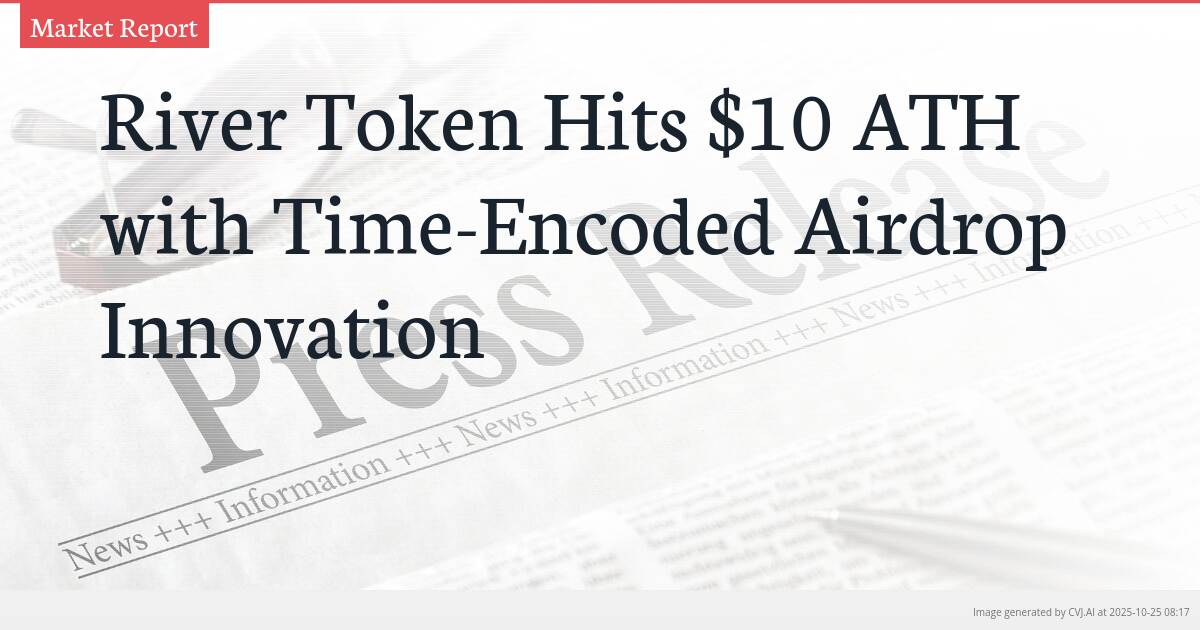This summary text is fully AI-generated and may therefore contain errors or be incomplete.
Introduction
The RIVER token has surged to a record $10, marking a 5x increase since its September token generation event, following its Binance Futures listing on October 17. This remarkable growth is driven by River’s groundbreaking Dynamic Airdrop Conversion system, which introduces time-encoded tokenomics that transform traditional airdrop mechanics into a dynamic market mechanism where conversion ratios evolve over a 180-day period.
Key Points
- River's Dynamic Airdrop Conversion allows 180-day conversion window with ratios improving over time, creating up to 270x difference in token output
- River Points function like call options on $RIVER, with value increasing as conversion ratios improve, enabling arbitrage strategies with perpetual futures
- The system has generated over $100M in 24-hour trading volume across Binance, Bybit, Bitget, KuCoin, and Gate exchanges with 80,000 eligible addresses
The Mechanics of Dynamic Airdrop Conversion
River’s Dynamic Airdrop Conversion represents a fundamental shift in token distribution methodology. Unlike traditional airdrops that conclude once tokens are claimed, River’s system begins precisely at that moment. The mechanism allows users to convert River Points (ERC-20 tokens) into $RIVER at any time within the 180-day window following the token generation event. This time-encoded approach creates a continuous market where conversion behavior directly influences token value and supply dynamics.
The system functions by treating River Points as call options on $RIVER, with their value increasing as conversion ratios improve over time. Market data shows River Points have risen 40x since launch, reflecting growing awareness of the arbitrage opportunities between River Points, $RIVER tokens, and perpetual futures. Users can either hold River Points for potentially higher future conversion ratios or lock in profits by shorting $RIVER perpetuals, creating a natural balance between liquidity and time-based appreciation.
The conversion curve demonstrates the dramatic impact of timing on token output. Holding 1 million River Points from Day 1 to Day 180 can result in up to a 270x difference in $RIVER received, depending on when conversion occurs. This structure makes time a direct variable in value determination, with prices moving according to market behavior rather than following fixed unlock schedules.
Market Response and Trading Dynamics
The market response to River’s innovative approach has been substantial, with $RIVER perpetual contracts now listed on major exchanges including Binance, Bybit, Bitget, KuCoin, and Gate. Trading volume exceeded $100 million in 24 hours, indicating strong market participation and liquidity. The ecosystem has attracted 80,000 eligible addresses and 40,000 X accounts for the River airdrop, demonstrating widespread community engagement.
Season 3 of the airdrop continues post-TGE, allowing users to accumulate additional River Points through various activities including stablecoin usage, social media engagement, and ecosystem campaign participation. This ongoing distribution mechanism maintains market interest while providing continuous opportunities for new participants to enter the ecosystem. The interplay between timing, conversion rates, and arbitrage strategies has generated significant discussion within the crypto community, with participants analyzing optimal conversion strategies and hedging techniques using perpetual contracts.
Broader Implications for Tokenomics
River’s Dynamic Airdrop Conversion reframes token distribution as an active market mechanism rather than a passive release schedule. The system establishes a measurable relationship between time, user behavior, and liquidity, where individual conversion decisions directly influence price formation and supply dynamics. This represents a significant evolution in tokenomics design, moving toward more adaptive structures where participation dynamics shape outcomes rather than predetermined parameters.
Within the cryptocurrency community, some view this innovation as comparable to the introduction of automated market makers in its potential to reshape market mechanics. The time-encoded framework creates an environment where value is continuously shaped by user activity and market behavior, potentially setting a new standard for token distribution models. As River continues building its chain-abstraction stablecoin system connecting assets, liquidity, and yield across ecosystems, this tokenomics innovation provides a foundation for more dynamic and responsive financial protocols.
📎 Read the original article on cryptopotato.com

